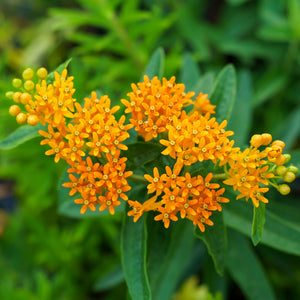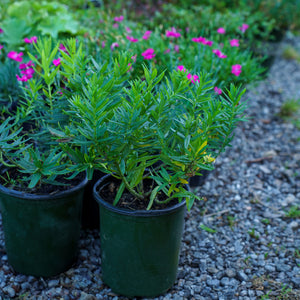The Asclepias Guide
Asclepias, commonly known as milkweed, is a group of hardy perennials celebrated for their vibrant blooms and critical role in supporting pollinators, particularly monarch butterflies. Native to North America, Asclepias species thrive in various growing conditions, from moist meadows to dry, sandy prairies. These resilient plants are drought-tolerant, deer-resistant, and essential for biodiversity, making them a must-have for pollinator gardens and native plant landscapes. Here’s everything you need to know about growing and caring for Asclepias.
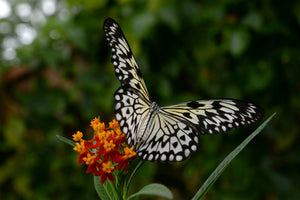
About
Asclepias belongs to the Apocynaceae family and includes over 100 species, each offering unique growth habits and flower colors. These plants are well known for their role in monarch butterfly conservation, as they serve as the sole host plant for monarch caterpillars. Their nectar-rich flowers also attract bees, hummingbirds, and other beneficial insects.
Popular species include Asclepias tuberosa (Butterfly Weed), with bright orange blooms; Asclepias incarnata (Swamp Milkweed), which thrives in wetter soils; and Asclepias purpurascens, known for its deep purple flowers. Cultivars such as Asclepias incarnata 'Cinderella', Asclepias incarnata 'Ice Ballet', and Asclepias tuberosa 'Hello Yellow' provide striking color variations.
Asclepias is an easy-to-grow, long-lived perennial that requires minimal maintenance once established. Whether planted in formal gardens, prairie restorations, or roadside plantings, these plants contribute to the health of local ecosystems while adding seasonal beauty to the landscape.
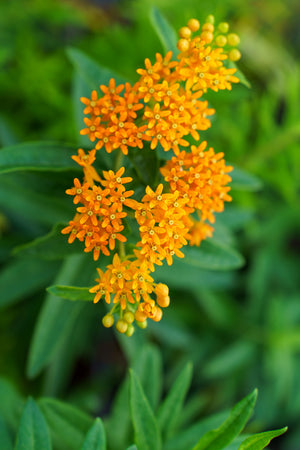
PLANTING
- USDA Hardiness Zones: Most Asclepias species thrive in Zones 3-9, depending on the variety.
- Soil: Prefers well-drained soil. Asclepias tuberosa thrives in sandy or rocky soils, while Asclepias incarnata prefers moist conditions.
- Sunlight: Requires full sun for optimal growth and blooming.
- Watering: Drought-tolerant once established, but newly planted specimens benefit from regular watering.
- Spacing: Space plants 12-24 inches apart, depending on the species, to allow for natural spreading.
- Planting Time: Seeds - Sow directly in fall for natural cold stratification or in early spring after a 30-day cold treatment. Transplants - Plant in spring or early fall when temperatures are mild.
To plant Asclepias from seed, scatter seeds over the soil surface and press them in lightly, as they require light for germination. Keep the soil moist until seedlings emerge.

CARE
- Watering: Water young plants regularly, but once established, most Asclepias species require little supplemental watering.
- Fertilizing: Generally not necessary, but a light application of compost in spring can encourage healthy growth.
- Pruning: Cut back stems in late fall or early spring to maintain a tidy appearance and remove dead material.
- Pests & Diseases: Resistant to most pests, but watch for aphids, which can be controlled with a strong spray of water. Milkweed beetles and tussock moth caterpillars may also feed on the plant but are typically not harmful.
- Dividing: Not usually required, but older plants can be divided in early spring if needed.
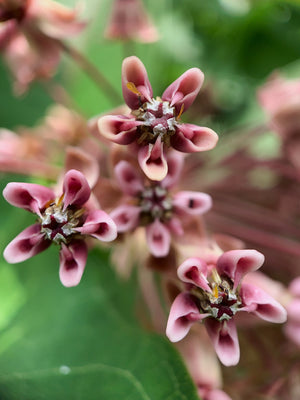
HOW TO USE
Asclepias is an essential addition to pollinator-friendly landscapes and conservation efforts:
- Pollinator Gardens: Supports monarch butterflies and other pollinators with nectar-rich blooms.
- Wildflower Meadows: Naturalizes well in prairie restorations and roadside plantings.
- Drought-Resistant Landscapes: Asclepias tuberosa is ideal for xeriscaping and sandy soils.
- Moisture-Rich Gardens: Asclepias incarnata thrives in rain gardens and along pond edges.
- Native Plantings: Complements other native species such as coneflowers, black-eyed Susans, and blazing stars.
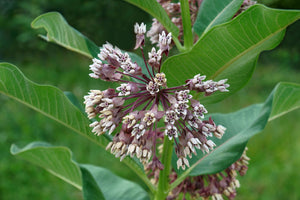
Common Questions
- When to plant Asclepias seeds? Sow seeds in fall for natural stratification or in early spring after a cold treatment.
- How to grow Asclepias tuberosa? Plant in well-drained soil and full sun, water until established, and avoid fertilizing heavily.
- Are Asclepias deer resistant? Yes, Asclepias is deer-resistant due to its milky sap, which is toxic to many herbivores.
- How to grow Asclepias from seeds? Cold stratify seeds for 30 days, then sow in early spring in well-drained soil with full sun.
- Are Asclepias poisonous to dogs? Yes, all parts of Asclepias contain cardiac glycosides, which are toxic to dogs if ingested.
- Are Asclepias poisonous to cats? Yes, Asclepias is toxic to cats and can cause gastrointestinal distress if eaten.
- Do monarch caterpillars eat Asclepias tuberosa? Yes, monarch caterpillars feed on Asclepias tuberosa, though they may prefer other milkweed species with softer leaves.
Conclusion
Asclepias is a vital plant for pollinator conservation, offering both beauty and ecological benefits. Whether you’re planting for monarch butterflies, adding seasonal color, or creating a drought-resistant garden, milkweed is an excellent choice. With selections like Asclepias tuberosa, Asclepias incarnata 'Cinderella', and Asclepias verticillata, there’s a variety suited for every landscape. Explore our collection and help support pollinators with these remarkable plants.
The Asclepias Collection
Sold Out
Sold Out
Sold Out
Sold Out



